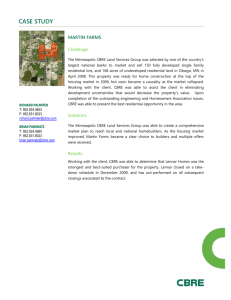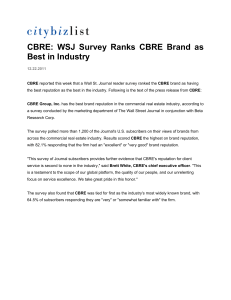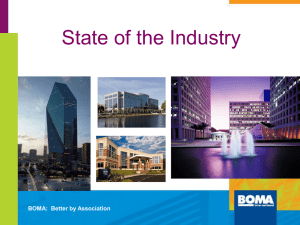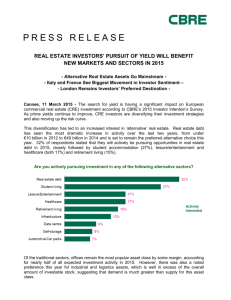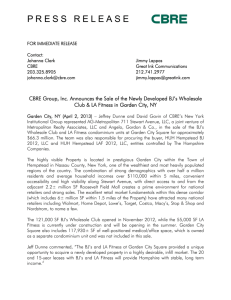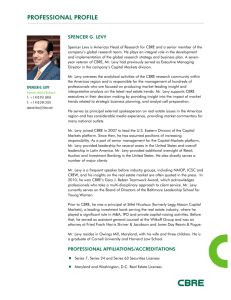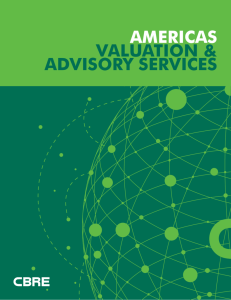Global investments in real estate: CBRE
advertisement
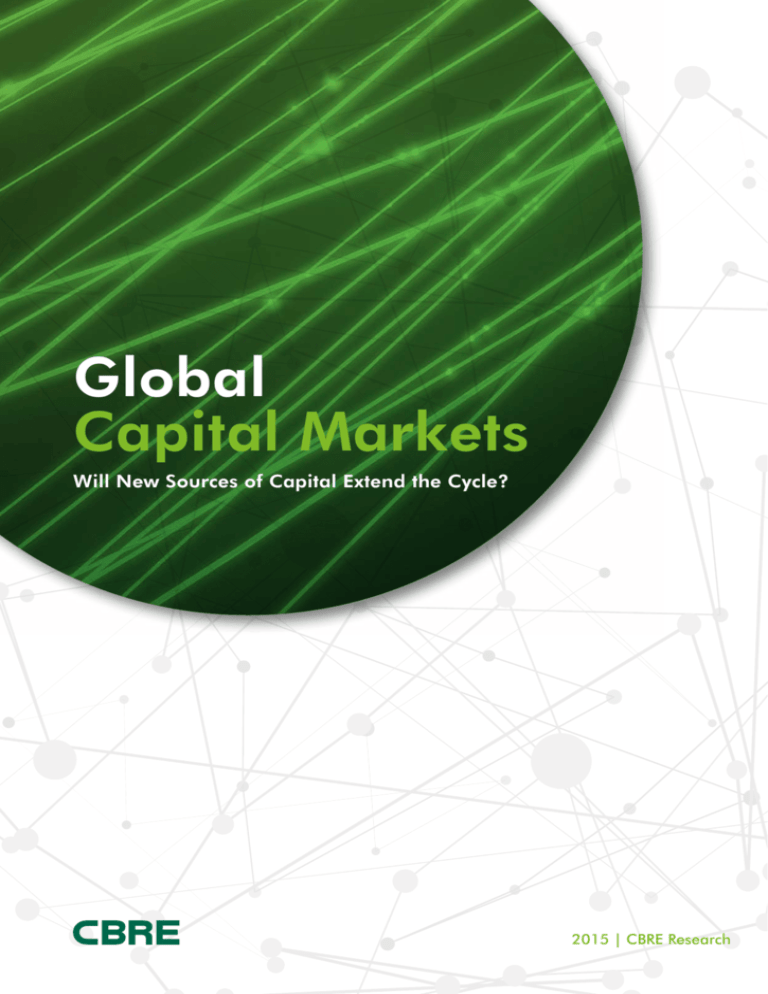
Global Capital Markets Will New Sources of Capital Extend the Cycle? 2015 | CBRE Research Contents Methodology This report is intended to capture capital flows as they relate to direct investment in standing commercial real estate. Transactions included in this analysis therefore relate to office, retail, industrial, leisure (including hotels) and mixed use property. Multi-family residential has been included in North America because of its importance as an institutional asset class in that region, attracting the same group of investors as are active in the commercial property sectors. It is also being included in certain EMEA markets where it is an institutional asset class. Purchases of land, either for development purposes or in agricultural use, are generally excluded. While development funding does not fall within our definition of ‘investment’, forward purchases of property that is still under construction are included. In terms of lot size, our data is aimed to cover all transactions of USD 1 million and above. 1 Global Investment Activity: Where in the Cycle? 2 2 The State of the Global Economy 4 3 Sector Analysis: Changing Investor Preferences, or a Natural Evolution? 6 4 Global Real Estate Values and Pricing 8 5 Top Destinations of Capital 10 6 Three Trends US Investors Should be Watching 12 7 Sources of Capital: the Tidal Wave of Cross-border Capital 14 8 New Sources of Asian Capital 16 9 Outlook and Market Opportunities 18 10 Key Statistics 20 Key Contacts Global Capital Markets 2015 | Will New SourcesGlobal of Capital Capital Extend Markets the Cycle? 2015 1 1 Global Investment Activity: Where in the Cycle? Global commercial real estate investment reached $407 billion in H1 2015, the strongest first half since the previous cyclical peak in H1 2007 ($442 billion). This previous peak was immediately followed by a US-led slowdown in the second half of 2007. Today we have a contrasting picture, with continued growth forecast for global investment activity overall in the second half of 2015, despite a slowing activity in Asia. Here are some key trends and factors worth watching in today’s market: • Slower and less uniform growth The global H1 2015 results were 14% up on the first half of last year. Though rapid growth in commercial real estate investment has been maintained for some time now, the rate of growth slowed in H1 2015. Growth globally has been far from uniform, with vastly different performances at a regional and country level. In dollar terms, while the Americas experienced investment growth of 31% year-on-year, investment in the EMEA region was up just 5% from H1 2014 and in Asia Pacific investment levels were down 19% y-on-y. • Exchange rate impacts The considerable strengthening of USD over the past year or so has had a significant impact. The results for non-USD denominated markets have been strongly affected by the shifts in exchanges rates. The growth in EMEA market appears significantly weaker in H1 2015 when measured in USD (5% y-on-y) compared to 25% when measured in local currency. The fall in the euro relative to the dollar is the key factor in this. The strength of the dollar also accentuated the fall in activity in Asia Pacific, with last year seeing the US dollar gain significantly up on many local currencies across the region, particularly Australia, Japan and South Korea. To compare and contrast the H1 2015 y-on-y growth results – a fall of 19% when measured in USD compares to a more moderate decline of 9% when measured in local currencies. Looking ahead, however, the key question is, – “Just how far along are we in the current investment cycle?” Comparing and contrasting the present with some key historic indicators is always a good starting point (see figure 2). Here too, notable regional differences can be seen – a comforting statement, which at the very least suggests that investors have learned something from the previous cycle and don’t seem to be ‘riding the wave’ of all core property priced the same, or at least not to the same extent as was the case in 2006-2007. Commercial real estate investment in the Americas in H1 2015 just surpassed the previous peak of $228 billon. EMEA region results are still short of the previous market high - the H1 2015 investment represents 78% of the H1 2007 USD denominated volumes. However, when measured in euros, the region is much closer to previous peak levels - at around 95%. a slowdown phase, driven by economic and wider financial market slowdown in the region, and in China in particular. The Asia Pacific region, on the other hand, looks to have already peaked in 2014. Since the global financial crisis (GFC) the region experienced much stronger economic growth relative to the Americas or EMEA, with a growing pool of capital seeking real estate exposure. As we stand today, Asian markets have already entered So what is next and just how far along are we in the current investment cycle? To answer just that question this report sets out to explore the key trends and drivers of the global commercial real estate investment market – starting from the state of the global economy to the key sources of capital and numerous expert insights. Figure 1 Global Commercial Real Estate Investment by Region Americas $US Billion 270 EMEA Asia Pacific 240 210 180 150 120 90 60 30 0 H1 2007 H2 2007 H1 2008 H2 2008 H1 2009 H2 2009 H1 2010 H2 2010 H1 2011 H2 2011 H1 2012 H2 2012 H1 2013 H2 2013 H1 2014 H2 2014 H1 2015 Source: CBRE Research, Real Capital Analytics, H1 2015 Figure 2 How Close to the Peak of the Investment Market? Global Investment Activity by Region on a 6-monthly basis Long-term average $US Billion 250 Current Previous peak Previous trough 200 150 100 50 0 Americas EMEA Asia Pacific Source: CBRE Research, Real Capital Analytics, H1 2015 2 Global Capital Markets 2015 | Will New Sources of Capital Extend the Cycle? © 2015 CBRE, Inc. © 2015 CBRE, Inc. Global Capital Markets 2015 | Will New Sources of Capital Extend the Cycle? 3 2 The State of the global economy Richard Barkham, PhD MRICS, Global Chief Economist, Global Research The Global commercial real estate investment market is now into a sixth year of growth, with significant amount of new capital bound for the market in the years to come. It is combined with strong sentiment right across a broader investor base, as indicated by the CBRE Global Investor Intentions Survey, rising values and good returns. Now, as momentum builds in the advanced economies we are also beginning to see a general increase in rental values, particularly in the US, but also in Europe. Is this market momentum about to come to a halt? We think not, for a number of reasons: Inflationary pressures remain very weak. Even though we have a good recovery in the OECD, there is still a negative output gap as indicated by high levels of unemployment in Europe and falling levels of capacity utilisation in US manufacturing; The shift away from manufacturing towards the service sector that is taking place in the Chinese economy as part of its managed transformation is transmitting a strong negative trade shock to other resource-based economies. These are mainly emerging markets, but also include Australia and Canada. It will take a while for the resource-based economies to return to full growth; “Will rising US interest rates destabilise world real estate markets?” After the most eagerly anticipated Federal open market committee (FOMC) meeting in many years the Fed funds rate was held at 0.25% in September. Although we stand at the beginning of a period of rising US interest rates the Fed has no need for haste. At 1.2% year-onyear, the main measure of core inflation in the US is well below target and, six years after the recovery began, we are only now beginning to see a meaningful rise in earnings. So the Fed can afford to wait until markets are less rattled, particularly about the state of the Chinese economy. However, we should be in no doubt that by the end of Q1 2016 short term interest rates will have begun to rise and they will not stop until they each at least 3%, probably around 2018. The UK will follow the US quite quickly, whereas the Euro area rates will rise only with a considerable lag, possibly up to 24 months. It shows wages are rising at 3.2%, up from 2.4% a year ago. It will only take a few reports of this nature to cause a spike in bond yields. In fact, we think this is a racing certainty. Rising bond yields could hit capital flows, at least for a while; There are of course risks to consider – these mainly lie in two areas: 2) The other risk lies, of course, in China. By and large we believe that a reasonably well-managed transition is underway and the economy is, even now, responding to interest rate cuts. However, the recent intervention in the stock market was poorly handled as was the currency devaluation, so it is possible that another ‘policy mistake’ in China will hit investor sentiment. There is also some concern about the fall in China’s foreign currency reserves, and the consequent reduction in its holdings of US bonds. China’s appetite for US treasuries has been one factor that has depressed long term interest rates over the last 15 years. 1) We are beginning to see a rise in wage rates in the US. The commonly quoted hourly wage rate is a poor indicator of what is going on, while the median income, computed by the Atlanta Fed, is better. Overall, however, we expect this economic cycle, albeit weak and volatile, to continue for a while yet and real estate, which is driven by this cycle, will continue to generate good returns for investors. Figure 3 World Economic Growth is Sluggish, but on Track The fall in commodity prices will exert downward pressure on global inflation for some while yet. Low inflation means that interest rates in the advanced world will rise only slowly and rates in the developing world, particularly Asia, are on a downward trajectory. Annual GDP growth Emerging Markets % 10.0 Advanced Economies World 8.0 6.0 4.0 2.0 0.0 -2.0 -4.0 -6.0 1990 1992 1994 1996 1998 2000 2002 2004 2006 2008 2010 2012 2014 2016 (F) 2018 (F) Source: Oxford Economics, CBRE Research, H1 2015 4 Global Capital Markets 2015 | Will New Sources of Capital Extend the Cycle? © 2015 CBRE, Inc. © 2015 CBRE, Inc. Global Capital Markets 2015 | Will New Sources of Capital Extend the Cycle? 5 3 Sector Analysis: Changing Investor Preferences, or a Natural Evolution? The last two years have seen a number of shifts in sector distribution of the global commercial real estate (CRE) investment market. The dominance of the office sector has been gradually eroding, from 46% of the market in 2007 to just 35% in H1 2015. At the same time investments in hotel and ‘other’ sectors have grown exponentially, reaching record levels in H1 2015, both in absolute terms, as well as a proportion of the global market. Although not evident in the results, the very strong investor interest in industrial and logistics will come through soon. Is the sector breakdown in the global investment market changing due to a natural evolution (i.e., markets maturing and developing a balanced sector mix in terms of investable stock)? Or is the change in sector preferences driven by a product scarcity? The answer is probably a mixture of both. These notable changes are no surprise, considering the global real estate investment market has been growing strongly since 2009, with lack of product posing a growing constraint on acquisition strategies. In fact, 40% of investors surveyed in CBRE’s 2015 Global Investor Intentions Survey identified either asset availability or competition from other investors as the main obstacle to acquiring assets in the current market. Putting the issue of asset availability aside, it is important to remember that the degree of sector change varies greatly from one region to the other. In the Americas sector distribution has been relatively unchanged since the growth phase began in 2009. This could be explained by it being one of the most mature and at the same time domestic investor-led markets. The on-going structural changes in the retail and industrial sectors and the growing influence of international capital are yet to have a significant impact on the sector distribution. Figure 4 Global Investment Market: Sector Distribution 2007 H1 2015 Office Retail Industrial Hotel Other V 6% 18% 46% 18% 9% 35% 11% 21% 24% 12% Source: CBRE Research, Real Capital Analytics, H1 2015 6 Global Capital Markets 2015 | Will New Sources of Capital Extend the Cycle? © 2015 CBRE, Inc. Figure 5 Global Commercial Real Estate Investment by Sector Office Share of the Total % 100 Asia Pacific Retail EMEA Industrial Hotel Other Americas 90 80 70 60 50 40 30 20 10 0 2013 2014 H1 2015 2013 2014 H1 2015 2013 2014 H1 2015 Source: CBRE Research, Real Capital Analytics, H1 2015 The situation is different in EMEA, where, of the three regions, the changes are most pronounced, especially considering the size of the market. For example, while offices attract a reduced share of CRE investment market globally, it is in EMEA that the fall is most pronounced, with the office share sliding from 53% in 2007 to 38% in H1 2015. The change is equally strong in the hotel segment: at 9% of the market in H1 2015, this is more than double the long-term average of 4%. Hotel assets have been particularly sought after by Middle Eastern investors and high-net-worth individuals (HNWI), with the typical list of safe haven locations of London, Paris and Berlin extended to include quality assets in the ‘recovery markets’, such as Italy, Spain and the Netherlands. The ‘other’ sectors, including student housing, healthcare, mixed-use and residential properties, have grown substantially as a destination for real estate investment, accounting for 24% of global CRE investment in H1 2015. The sector has long played © 2015 CBRE, Inc. an important role in the Americas due to the large multi-family sector. Here too, the growth of the sector has been most striking in the EMEA region, with an increased interest in mixed-use portfolios, student housing and healthcare. With strong yield compression in more traditional CRE sectors, investors are turning to alternatives as they search for higher returns. On the topic of hotels, the growth of international tourists into Asia Pacific also triggered strong interest for quality hotel investments, especially in Australia, Hong Kong and Japan. However, this activity tends to be very ‘lumpy’ with a small number of large deals inflating the results. In fact, this can be applied more broadly across the sectors as it is the Asia Pacific region where more sector-rebalancing is expected. As many of the Asian markets are still developing, their sector mix is currently heavily weighted towards the office segment much more than is the case elsewhere and this ought to start correcting over the medium term. Global Capital Markets 2015 | Will New Sources of Capital Extend the Cycle? 7 4 Global Real Estate Values and Pricing The total value globally of commercial real estate transactions has been rising rapidly nearly everywhere and, as in previous cycles, this growth in activity is associated with sustained capital value growth in all of the global regions. The rate of growth has not been as high as was experienced in 2005-2007, but it is being sustained for longer. The Asian markets are an exception to this, having got closer than those in EMEA and the Americas to matching pre-crisis growth rates in the current cycle. This sustained capital growth has taken values – on average – beyond the pre-crisis peak in nearly all sector/region combinations. The only exception being EMEA Industrial, which is a function of underperforming rents that are still about 6% below the previous peak. However, even then, EMEA Industrial is only just below the pre-crisis peak and will almost certainly surpass it shortly. At this stage in the cycle it is to be expected that capital value growth would be running well ahead of rental value growth in most places, and that is indeed the case. After the very severe recession of 2009-2010, it is no surprise that it has taken a long time for occupiers to reach the point where they are ready to make substantial commitments to additional accommodation. There has also been excess supply to absorb in many places before demand would start driving rental growth. The exceptions to this are (again) most of the Asian markets, where the recession was generally less severe than elsewhere, and the recovery in occupier demand was quicker. The decline in yields/cap rates has led to concern over the sustainability of the current level of pricing, especially for prime real estate. In most major markets around the world the current prime yield is well below the long-term average for that market and, in some instances, is at a record low. However, in addition to this local time series approach, it is also useful to consider real estate pricing in a multi-asset context. Government bond yields in most countries are also at historically low levels. Consequently the price differential between prime property and government bonds still looks fairly healthy, especially in the context of improving occupier demand and, therefore, improving rental growth prospects. Another feature that stands out from this type of analysis is the similarity in pricing across the major markets. In nearly all the spread between prime office yields and 10-year government bond yields lies in the range 1 to 3%. The exception is most of the Asian markets, where the spread is much lower. Bond yields are generally higher in the Asian markets than elsewhere, a function of the stronger economic position which means that there is less of an imperative for governments to stimulate investment. In some of the key Asian markets prime office yields are also lower than in equivalent markets elsewhere, reflecting the well-funded institutional investors in the region, the relatively small supply of prime real estate and historic bias (often due to regulation) in terms of investment in home markets. This provides one of the explanations for the current substantial flows of Asian capital into real estate in other global regions. Figure 7 Global Real Estate – Bond Yield Gap Prime Office Yield (net) Relative to 10-year Government Bond, Q2 2015 10-year Government Bond Spread Prime Office Yield % 12 10 Figure 6 CBRE Global Capital Value Indices 8 All Property, Annual Growth Rate Asia Pacific % 40 Americas EMEA 6 4 30 2 20 0 -2 10 -4 0 -6 Amsterdam Brussels Copenhagen Berlin Frankfurt Munich Hamburg Helsinki Zurich Dublin Vienna Stockholm Paris Milan Madrid Melbourne Dallas Sydney Toronto EMEA London WE Source: CBRE Research, H1 2015 Chicago Q2 2015 Pacific Vancouver Q2 2014 Boston Q2 2013 New York Q2 2012 Los Angeles Q2 2011 Seoul Q2 2010 Tokyo Q2 2009 Beijing Q2 2008 Americas Mumbai Q2 2007 Shanghai Q2 2006 Hong Kong Q2 2005 Taipei Q2 2004 New Delhi -30 Asia -10 San Francisco -8 -20 Singapore -10 Source: CBRE Research, Bloomberg, end of Q2 2015 8 Global Capital Markets 2015 | Will New Sources of Capital Extend the Cycle? © 2015 CBRE, Inc. © 2015 CBRE, Inc. Global Capital Markets 2015 | Will New Sources of Capital Extend the Cycle? 9 5 Top Destinations of Capital The USA, UK and Germany remain, by far, the three largest CRE investment markets globally. A combined total of $301 billion transacted in these three countries in H1 2015, an unusually high (74%) share of the global market and some 10% above the long-term average of 64%. The last time joint investment in these markets grew to this level, albeit a little higher, was during 2006-2007. Some would draw the conclusion that this indicates how close we are to the cyclical peak, although the economics suggest that capital flows are still well supported. Figure 8 Key Destinations: Top 20 Markets and their Respective Rankings by Total CRE Investment US$ Billion Rank 2013/Rank 2014/Rank H1 2015 Significant improvement in rankings Notable fall in rankings No notable change United States of America $222.4 bn United Kingdom $54.6 bn Rank 1/1/1 Rank 2/2/2 Germany $24.0 bn Rank 3/3/3 Japan $13.0 bn Rank 5/4/4 Although the top of the hierarchy remains the same, a number of changes can be observed due to two major influences - regional economic trends and the growing influence of international capital. On the other hand, rapid uplifts in investment in Europe’s recovery markets, such as Italy, Ireland and Spain, meant significantly improving positions in the H1 2015 top 20 market rankings. • Regional trends have shaped the latest results quite strongly. Weaker investment activity in Asia due to a combination of expensive, in a global context, pricing and the recent economic slowdown in the region, China in particular, has led to China, South Korea and Singapore sliding down the top 20 market rankings in H1 2015. • At the same time the common thread across most of the ‘growth markets’ has been the increasing influence of international capital. Spain and Norway, for example, moved into the top 10 destinations in H1 2015 largely as a result of this, with international capital accounting for 31% and 54% of their respective totals. Canada was the only non-Asian market to see a notable fall in rankings. With several of its regions relying heavily on oil for economic activity, the current economic slowdown has already had an impact on occupier fundamentals. This, combined with a growing development pipeline, has resulted in a significantly weaker investment market in H1 2015, and similar expectations for the year as a whole. A quick look at the world’s top 20 largest cities in terms of total CRE investment, compared to the top 20 locations in terms of international capital flows, helps to understand how cross-border investors are changing the shape of the market. The list of top 20 international destinations in H1 2015 comes across as a balanced mix of cities across all main regions, with half of all locations being European. This contrasts with the overall top destinations where the bias is strongly on the USA (please refer to sections 7-8 of the report, where the topic of key sources of capital will be explored in more detail). Figure 9 Key Destinations of Capital: Top 20 Cities in H1 2015 By Total Investment By International Capital Flows Only US$ Billion Australia $10.3 bn Spain $9.3 bn France $8.8 bn Norway $6.8 bn Sweden $6.5 bn Hong Kong $5.5 bn Canada $5.2 bn Netherlands $4.6 bn Switzerland $1.8 bn Rank 4/6/5 Rank 16/11/6 Rank 7/5/7 Rank 18/14/8 Rank 9/8/9 Rank 10/13/10 Rank 6/7/11 China $4.0 bn Italy $3.8 bn Finland $2.5 bn Ireland $2.5 bn Singapore $2.4 bn South Korea $2.1 bn Denmark $2.0 bn Rank 8/10/13 Rank 17/15/14 Rank */16/15 Rank */17/16 Rank 11/18/17 Rank 12/9/18 Rank 19/19/19 Rank 13/12/12 Rank */*/20 *Not in top 20 Source: CBRE Research, Real Capital Analytics, H1 2015 London New York Paris (IDF) Sydney Hong Kong Washington DC Milan Hawaii Frankfurt Munich San Francisco Prague Berlin Dublin Tokyo Shanghai Copenhagen Hamburg Miami/South Florida Houston New York London Los Angeles San Francisco Chicago Washington DC Miami/South Florida Tokyo Boston Atlanta Dallas Paris (IDF) Seattle Hong Kong Houston Denver Phoenix San Diego Orlando Sydney 0 5 10 15 20 25 30 35 40 0 2 4 6 8 10 12 14 Source: CBRE Research, Real Capital Analytics, H1 2015 10 Global Capital Markets 2015 | Will New Sources of Capital Extend the Cycle? © 2015 CBRE, Inc. © 2015 CBRE, Inc. Global Capital Markets 2015 | Will New Sources of Capital Extend the Cycle? 11 6 Three Trends US Investors Chris Ludeman, Global President, Capital Markets There is an old expression, “it’s not what you make, it’s what you keep that matters.“ This is top of mind for many US property investors these days. A host of new factors, from China and currency values to oil prices, are having an impact on net property returns, the ’what you keep’, both at home and abroad. While the marketplace will continue to pay close attention to the ’usual suspects’— economic growth, interest rates and unemployment, these are three trends also worth monitoring closely: including Australia, Canada, Chile and Brazil. While this trend is making the export of capital from these countries more expensive, expect rising inflows from countries with strong currencies like the US. • China There are many ramifications of China’s construction and investment super-cycle (and the associated commodities super-cycle) of the past 10 years, but the most immediate effect has been the growing pool of Chinese capital now being exported to global commercial real estate. • ‘Permanent’ capital One of the most important shifts in real estate since the global financial crisis has been the rise of ’permanent’ capital. Investors such as REITs and sovereign wealth funds don’t have to trade assets as they are not subject to short-term return metrics that tend to make traders out of investors in many other asset classes. In the US alone, Chinese capital inflows into real estate totaled $3.7 billion in H1 2015, almost four times higher than the circa $1 billion reported in H1 2014. At this rate, China might come really close to being the top foreign investor into US real estate in 2015. As it stands, the H1 2015 results are second only to Canadian buyers, who invested $4.7 billion. Moreover, Chinese investors are targeting development sites, which foreign investors have historically avoided. Elsewhere, the slowdown of the Chinese economy has negatively impacted the economies and currencies of countries largely reliant on commodity exports, 12 In 2014, REITs and SWFs accounted for 32% of international capital flows into US gateway cities, up from 0% in 2009. Although the H1 2015 results are lower, the 2015 year-end results are expected to confirm this on-going trend. The growing presence of ’permanent’ capital is equally strong in Europe’s top markets, where its share reached 25% in H1 2015, up from only 4% in 2010. If these investors ’keep’ rather than sell, it will further exacerbate the supply (of assets)-demand (from capital) imbalance and possibly lead to ’permanently’ lower cap rates in core markets. Global Capital Markets 2015 | Will New Sources of Capital Extend the Cycle? © 2015 CBRE, Inc. • The bounce-back of Southern European markets and Ireland In Europe, property markets in Spain, Portugal and Ireland have gone through bust-boom cycles over the last seven years. (Greece and Italy are still in the process of recovering, but foreign capital is chasing assets in anticipation of a future boom). Spain has seen rapid improvement in its real estate markets over the last few years. Many investors who got into Spain early rode this wave, in part fueled by large US private equity companies driving up prices. At the same time, however, although returns in local currency have been phenomenal, many of these gains were surrendered with the rapid devaluation of the euro. What those US investors ultimately ’kept’ was quite a bit different than their paper gains in a foreign currency. Figure 10 Rise of ’Permanent’ Capital: International Capital Flows US Gateway Markets* % 100 6 34 Top European Markets** 0 6 9 16 16 32 11 % 100 80 80 60 60 40 40 20 20 0 2007 2008 2009 2010 2011 2012 2013 2014 H1 2015 0 Other REITs/SWFs 3 8 7 4 13 20 25 13 25 2007 2008 2009 2010 2011 2012 2013 2014 H1 2015 * New York, Boston, Washington DC, Chicago, San Francisco and Los Angeles ** London, Paris, Stockholm, Berlin, Frankfurt, Hamburg and Munich Source: CBRE Research, Real Capital Analytics, H1 2015 © 2015 CBRE, Inc. Global Capital Markets 2015 | Will New Sources of Capital Extend the Cycle? 13 7 Sources of Capital: The Tidal Wave of Cross-border Capital Cross-border capital flows have grown in influence to become an important driver of the CRE investment market globally, particularly in the last 24 months. At a regional level, the degrees of influence vary from as little as 10% in Americas to almost 50% of the market in the EMEA region. Regardless of the current shape, however, the influence is growing to the point that international capital is becoming the ’market-maker’ in setting the price in the most desired and liquid investment markets across the globe. The largest contributor to these flows in the first half of the year was the USA, accounting for a stand-out US$25.4 billion of investment outside its home market. The next three greatest sources were Canada, Germany and China respectively, though even together, their contribution fell short of that from the USA. Picking on a few familiar capital sources first: • We have the recurrent wave of American equity funds, eager to explore international opportunities in search of higher returns. The most obvious group being opportunistic funds, off the back of strong buying power of the US dollar, seeking exposure in non-USD markets to take advantage of the relatively cheap pricing. US investors have tended to favour markets where the recent appreciation of the dollar has given them an advantage against domestic buyers. Several large US private equity funds have substantially increased their holdings outside of the US in H1 2015, often making large portfolio acquisitions for a quick route into the market and to maximise exposure; • There is some good old German money looking for steady investments outside their home market, with over $7.1 billion invested in H1 2015 alone. Although Germany ranks as a third largest source of cross-border capital globally, most of this investment is within Europe – a notable shift in strategy post-GFC; Within this growing wave of cross-border capital, there are elements of old and new, that draw interest due to the broader implications they have for the global CRE investment market. • Despite the low oil prices Middle Eastern purchasers remain very active, collectively investing $11.5 billion outside of their home markets in H1 2015. While recent activity was helped by a small number of large sovereign wealth fund deals, the investor base is growing and so are their investment strategies towards greater geographic and sector diversification, with activity spreading beyond gateway markets to second-tier locations in Europe and the Americas, and more recently towards core Asia Pacific. There are numerous new sources of capital that have emerged only recently: • Canada has risen in importance as a crossborder investor, with its commodity driven economy struggling and the Canadian Dollar trading at an eleven-year low (August, 2015), Canadian companies and investors have sought opportunities abroad. In H1 2015 they were the second largest international buyers globally with $8.5 billion – 63% more than the total transacted in their home market; • Weaker oil prices are a strong contributing factor to the growth of non-institutional investment from the Middle East, triggering and accelerating global deployment of capital from private net worth in particular. Keeping in mind the lifting of Iranian sanctions expected in early 2016 – a fresh wave of new private capital is expected from Iran in the coming few years, which might initially target residential / multi-family sector; • However, of all new sources of capital – Asia has been the most captivating due to the size, speed and potential long-term impact brought by the recent regulatory changes, allowing many of the local pensions funds and insurance companies to invest internationally (please read on to the next section for more details). Figure 12 Top Sources of Cross-border Capital in Global CRE by Buyer Origin in H1 2015 Figure 11 Global Commercial Real Estate Investment by Buyer Orgin US$ Billion % 100 90 International Domestic Share of the Total Americas 8 Asia Pacific 10 9 23 24 USA $25.4 bn EMEA 33 41 44 48 80 70 Canada $8.46 bn 60 50 Germany $7.12 bn 40 30 20 10 0 2013 2014 H1 2015 2013 2014 H1 2015 2013 2014 China $6.58 bn Qatar $5.24 bn Sweden $1.83 bn Taiwan $1.79 bn UK $5.20 bn UAE $4.54 bn Singapore $4.40 bn France $4.32 bn Switzerland $4.16 bn H1 2015 Source: CBRE Research, Real Capital Analytics, H1 2015 Australia $2.92 bn Hong Kong $2.23 bn Finland $1.67 bn South Korea $1.54 bn Spain $1.39 bn Norway $1.35 bn Malaysia $0.90 bn Thailand $0.74 bn Japan $0.71 bn Source: CBRE Research, Real Capital Analytics, H1 2015 14 Global Capital Markets 2015 | Will New Sources of Capital Extend the Cycle? © 2015 CBRE, Inc. © 2015 CBRE, Inc. Global Capital Markets 2015 | Will New Sources of Capital Extend the Cycle? 15 8 New Sources of Ada Choi, CFA, Head of Capital Markets Research, Asia Pacific Driven by the rapid growth of savings in the region and the desire for diversification, Asian cross-border investment in global commercial real estate has surged in recent years. It doubled between 2012 and 2013, followed by further growth of 15% y-o-y in 2014. The H1 2015 total reached US$19 billion, with China taking over as the biggest source of outbound capital with US$6.6 billion of foreign real estate purchases. The next biggest investors in international real estate from the region were from Singapore with US$4.4 billion and Hong Kong with US$2.2 billion. Asian buyers accounted for 19% of global cross-border investment in H1 2015. Although growth in Asian outbound investment has been slower in H1 2015, there are a number of factors leading CBRE to believe that Asian buyers will remain a significant force in the global real estate investment market. These include: • Low allocations to real estate among institutional investors Asian institutional investors’ allocations to real estate stand at just 2.0%, well below the international average of 4-6%. While recent regulatory changes have permitted overseas investment by Chinese and Taiwanese insurers, pension funds, and particularly private groups, are still subject to various restrictions prohibiting them from investing in real estate, even in their domestic markets. This is set to change, however, with Japanese institutional investors in particular expected to turn more active in the coming years. The Japan Government Pension Investment Fund (GPIF), the world’s largest pension fund, 1 has announced plans to invest in alternative sectors including real estate, with a target allocation of 5.0% of its total asset size of US$1.2 trillion. • Strong wealth growth among HNWIs Wealth accumulated by high-net-worth individuals (HNWIs) in Asia Pacific grew at a compound annual growth rate (CARG) of 10.4% to US$15.8 trillion in the period between 2009 and 2014, well above the equivalent global growth rate of 7.7%1. According to the World Wealth Report 2015, allocations to real estate by HNWIs in Asia Pacific stand at 19%, higher than the global average of 17.6%. HNWIs in Asia Pacific tend to buy overseas housing for investment and also for self-use or for their children studying overseas. Many super HNWIs also invest in CRE. Strong demand for overseas housing from regional HNWIs will continue to spur Asian developers to invest in overseas markets, including development projects and sites. Figure 13 High-Net-Worth Wealth in Asia Pacific US$ Trillion $ $15.82 tn 2014 $ $ $14.24 tn 2012 $ $ $ $9.65 tn 2009 World Wealth Report 2015, Capgemini & RBC Wealth Management $ $ $ $14.20 tn $ $ 2013 $ $ $10.8 tn 2010 $ $ $ $10.7 tn 2011 • Robust long-term appetite among Chinese investors The recent equity market correction and devaluation of the Yuan have resulted in a short-term increase in capital flows out of China, reflected by a US$94 billion decline in China’s foreign reserves to US$3.6 trillion in August. The central government has responded by introducing restrictions on capital outflows, including tightening foreign currency conversions for non-business purposes by domestic entities and individuals. This move is set to inhibit activity by Chinese investors in the global market, at least in the shortterm. Although several large Chinese investors still have offshore capital to deploy, they could opt to delay their investment decisions in order to comply with central government policy. In the longer term, however, Chinese investors will retain a strong appetite for acquisitions in major global gateway cities and will continue to expand their portfolios beyond their domestic market. Source: Capgemini Financial Services Analysis, 2015 16 Global Capital Markets 2015 | Will New Sources of Capital Extend the Cycle? © 2015 CBRE, Inc. © 2015 CBRE, Inc. Global Capital Markets 2015 | Will New Sources of Capital Extend the Cycle? 17 9 Outlook and The bottom line is that real estate, even ignoring rental value growth, still offers a ‘spread’ over bond rates of between 200 to 300 on average across world real estate markets, so we expect capital to continue to be attracted to the sector. Investment volumes may not increase at the rates they have done over the last several years, access to stock is a limiting factor, but there is no reason why they should not grow in H2 2015 and 2016. Asia is the only regional exception and London may be close to a plateau. We do not think that China is ‘falling off a cliff’, but we do see a degree of economic weakness in the region for twelve months or so until domestic demand makes up for falling export growth. Lower yields and a weakish rental outlook in the Asia Pacific region, with the notable exception of Japan, may deter investors, despite the favourable long term outlook. This does put Japan back on the investor map, with well-located offices in Central Tokyo and major regional cities, such as Osaka, looking favourable. This extends to the hotel sector in those locations, performing well off the back of a pent up demand from a growing number of visitors. Nevertheless, we will also see strategic acquisitions by international buyers with a long-term investment horizon, the so-called ’permanent capital’. Some such examples have already taken place in H1 2015, with a number of prominent SWFs growing their exposure in the Asia Pacific region. Shifting to the US and Europe, we expect core real estate to generate rates of return of between 6% and 8% for the next three years at least, with a greater proportion of the return due to rental value appreciation. Given positive investor sentiment there 18 may be some further yield reduction, but significantly less so than over the last several years. At the same time, investors will continue to venture up the risk curve in terms of real estate risk and leverage, and in fact it is in the more secondary space where both rental growth and yield compression is expected to be greater. This is especially the case for the US, where the economic and occupier recovery has been stronger. In-fill light industrial may be the new US opportunity to explore, given changes driven by e-commerce and re-emergence of single-family home building. In Europe, there are still some opportunities in value-add for assets where the existing owner has underinvested during the years of weak economic growth. This would include offices in Western European CBD locations (excluding the UK) in need of refurbishment, where occupier markets are starting to pick up and there is not much new development to compete with. Some town/city centre shopping centres that are in need of refurbishment of common areas and, often, tenant improvements also look attractive. Furthermore, some yield premium still exists for some of Europe’s emerging sectors that are moving into the mainstream – such as student housing, healthcare and hotels – but it is eroding rapidly. US investors are also active in exploring ’niche’ product strategy to find new opportunities, but the emphasis here is on the demand side of things, with no much pricing premium compared to the mainstream assets. Global Capital Markets 2015 | Will New Sources of Capital Extend the Cycle? © 2015 CBRE, Inc. Key Takeaways 1 Global investment volumes to grow in H2 2015 and 2016. Asia is the only regional exception, and London may be close to a plateau 5 Europe and the US will see investors venture up the risk curve – and it is in the more secondary space that both rental growth and yield compression will be stronger 2 With weaker fundamentals in Asia Pacific, Japan is back on investor map, with offices and hotels in major regional cities expected to perform really well 6 These are value-add opportunities in Western European CBDs (bar the UK) for office and shopping centre assets in need of refurbishment 3 ‘Permanent capital’ to continue investing around the globe – strategically and with a long-term horizon in mind 7 In-fill light industrial is the new US opportunity to explore as changes in e-commerce and the re-emergence of single-family home building stimulate demand. 4 New sources of capital are helping to extend the investment cycle, as well as driving ‘old capital’ expansion into ‘niche’ sectors © 2015 CBRE, Inc. Global Capital Markets 2015 | Will New Sources of Capital Extend the Cycle? 19 10 Key Statistics Figure 14 Global Commercial Real Estate by Region* Americas EMEA Asia Pacific Cross-regional Capital Flows reached $67.5 billion in H1 2015, a 31% increase on H1 2014 $US Billion 500 450 400 350 300 72 40 45 174 100 40 33 82 193 50 0 H1 2007 50 46 200 228 41 61 186 250 150 Figure 16 Global Capital Flows in H1 2015* H2 2007 92 110 140 H1 2011 H2 2011 97 37 137 50 119 H1 2012 209 184 159 H2 2012 H1 2013 137 130 90 71 171 245 229 H2 2014 H1 2015 175 H2 2013 H1 2014 6.6 25.7 5.8 6.0 North America Source: CBRE Research, Real Capital Analytics, H1 2015 *All commercial real estate and hotels, including multi-family sector in the North America 6.2 Figure 15 Global Commercial Real Estate by Sector* 0.6 Europe 2.6 0.8 Long-term 6-monthly average H1 2011 H2 2011 H1 2012 H2 2012 H3 2013 H3 2013 H4 2014 H4 2014 H5 2015 Office 203 114 78 105 85 120 106 156 133 191 141 Retail 81 62 53 62 51 76 63 90 79 96 85 Industrial 51 33 24 31 25 39 35 46 43 54 39 Hotel 34 21 17 19 14 21 24 32 29 33 45 Other 78 60 52 55 53 71 70 83 70 113 96 All Sectors 442 289 224 271 227 327 298 407 355 488 407 Asia Africa Europe Middle East North America Pacific South America 0.3 Asia Middle East Africa (w/total outbound capital, USD) Previous cycle peak 0.6 2.4 1.9 Buyer Origin Key US$ Billion 2.4 0.7 0.1 South America 0.4 0.1 0.6 Pacific DESTINATION CAPITAL North America SOUR CE OF CAPI TAL Source: CBRE Research, Real Capital Analytics, H1 2015 *All commercial real estate and hotels, including multi-family sector in the North America Asia Europe Pacific Others 8.4% 89.4% 2.2% 0% 40% 22.1% 0.4% 52.2% 3.5% 0.8% 0.4% 0.4% North America US$ 28.8 bn Asia US$ 16.5 bn 37.5% Middle East US$ 11.5 bn 22.6% 20.8% Europe US$ 6.4 bn 90% 9.3% Pacific US$ 2.9 bn 65.3% 10.2% 24.5% Africa US$ 0.8 bn 0% 0% 94.7% 5.3% South America US$ 0.6 bn 97.4% 0% 2.6% 0% 0% 0% Source: CBRE Research, Real Capital Analytics, H1 2015 *All commercial real estate and hotels, including multi-family sector in the North America 20 Global Capital Markets 2015 | Will New Sources of Capital Extend the Cycle? © 2015 CBRE, Inc. © 2015 CBRE, Inc. Global Capital Markets 2015 | Will New Sources of Capital Extend the Cycle? 3.6 Key Contacts For more information regarding this report please contact: Richard Barkham, PhD. Global Chief Economist t: +44 207 182 2665 e: richard.barkham@cbre.com Iryna Pylypchuk Director, Global Research t: +49 6917007792 e: iryna.pylypchuk@cbre.com Capital Markets Global Research Leadership Christopher Ludeman Global President t: +1 212 9848330 e: chris.ludeman@cbre.com Nick Axford, PhD. Head of Research, Global t: +44 20 7 182 2876 e: nick.axford@cbre.com Regional Capital Markets Research Ada Choi Head of Capital Markets Research, Asia Pacific t: +852 2820 2871 e: ada.choi@cbre.com.hk Michael Haddock Head of Capital Markets Research, EMEA t: +44 20 7182 3274 e: michael.haddock@cbre.com Jeanette Rice Head of Investment Research, Americas t: +1 214 9796169 e: jeanette.rice@cbre.com Neil Blake, PhD. Head of Research, EMEA t: +44 20 7 182 2133 e: neil.blake@cbre.com Follow Neil on Twitter: @NeilBlake123 Henry Chin, PhD. Head of Research, Asia Pacific t: +852 2820 8160 e: henry.chin@cbre.com.hk Follow Henry on Twitter: @HenryChinPhD Spencer Levy Head of Research, Americas t: +1 617 9125236 e: spencer.levy@cbre.com Follow Spencer on Twitter: @SpencerGLevy To learn more about CBRE Research, or to access additional research reports, please visit the Global Research Gateway at www.cbre.com/researchgateway. CBRE Disclaimer 2015 CBRE Limited confirms that information contained herein, including projections, has been obtained from sources believed to be reliable. While we do not doubt their accuracy, we have not verified them and make no guarantee, warranty or representation about them. It is your responsibility to confirm independently their accuracy and completeness. This information is presented exclusively for use by CBRE clients and professionals and all rights to the material are reserved and cannot be reproduced without prior written permission of CBRE. www.cbre.com
